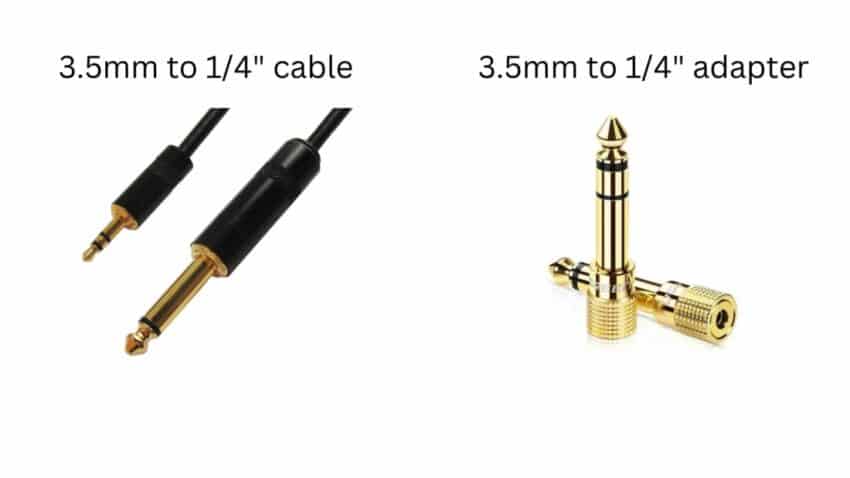It’s a common misconception that USB microphones can’t be connected to a mixer or a USB Audio Interface, and although it’s not all that common nor best practice, it’s something that can be done.
In this article, I will be going over how you can connect your USB microphone to a Mixer, the reasons to do it as well as not to, and what better alternatives you have at your disposal.
So, without any further ado, let’s get started!
How to plug a USB Microphone into a Mixer
Although connecting a USB microphone to an audio mixer, or audio interface for that matter, may not be that common, it is something that can be done.
It’s worth noting, however, that USB mixers don’t offer USB Inputs, meaning that you can’t simply connect the USB cable from the mic to the mixer as you would on the PC.
To actually achieve this, you will need to get the audio signal from the headphone output of the microphone and send that to the mixer, and there are a few ways to do this but the simplest and most-recommended one is as follows:
But before I get into the actual steps, let me tell you what you’ll need to be able to do this.
What you will need:

- A 3.5mm jack to ¼” TRS cable.
- Or you can also use a 3.5mm to 3.5mm audio cable with a ¼” adapter.
Once you have the cable, you’re ready to connect the USB mic to the mixer:
How to connect the USB mic to the Mixer:

- Connect the 3.5mm end of the audio cable to the headphone output of the USB mic.
- Connect the other end to one of the combi XLR/TRS inputs on the Mixer making sure that the gain on the input you’re connecting it to is turned all the way down (don-t use the insert, line-in, or Instrument level jacks).
- Increase the gain and the headphone volume on the mic (make sure that the headphone volume doesn’t exceed 50% as it may introduce distortion).
- Set the mixer output level to “Unity” (generally shown as a triangle on the output/mix knob on the mixer).
- Increase the Gain of the channel that the mic is connected to on the mixer until you get a respectable level (Usually shown as “0” on the metering display).
And that’s about it, you don’t need to do anything else in order to be able to connect your USB mic to a Mixer.
Reasons to plug a USB mic into a Mixer
USB microphones are generally not very versatile and, in fact, they normally just allow you to record a single track at a time.
Connecting it to a mixer lets you record multiple simultaneous inputs like you would when using XLR microphones, which, essentially, bypasses this issue and lets you record as many tracks as the mixer allows.
Reasons NOT to plug a USB Mic into a Mixer
Converting audio back and forth from analog to digital, which is what an audio interface does as well as USB microphones, USB mixers, etc., tends to degrade the audio signal somewhat, plus having additional cables can introduce noise as well as extra points of failure.
This means that in order to get the cleanest and best-sounding signal possible, you should always try to use as few cables as possible and don’t have the signal be converted from analog to digital and back multiple times.
Not only that, but generally speaking, cables tend to pick up noise such as radio station signals, etc., and the longer they are the more noise they will pick up. This is only an issue with unbalanced cables which is why you should always use balanced ones (read my article on the differences between balanced and unbalanced cables to learn more).
Recommendation: Get a mic with USB and XLR Outputs
Even though you can connect a USB mic to a mixer or Audio Interface by following the steps I just laid out, it’s definitely not the best way to go about it.
The absolute best way is, however, to get a USB mic that also has an XLR output that can be used to connect the mic to any external equipment.
This way, you avoid converting the audio from analog to digital and back multiple times, you don’t need to use multiple cables since you only need one XLR cable, and you’re using a balanced connection that doesn’t introduce any noise or interference.
Here’s an article where I talk about the Shure MV7 and compare it to another mic, but it’s a microphone that features both USB and XLR connectivity, providing you with the best of both worlds.
Conclusion
While you can definitely connect a USB microphone to a USB mixer, Audio Interface, etc., it’s not the best way of going about it since the audio signal might be degraded, although very slightly, plus you’ll need to use multiple cables which introduces additional points of failure.
I’d recommend going for a mic that offers USB and XLR connectivity if you still didn’t buy a mic, otherwise just follow the steps laid out in this article and you should be fine, no need to go out and get an additional microphone if you don’t need to.
